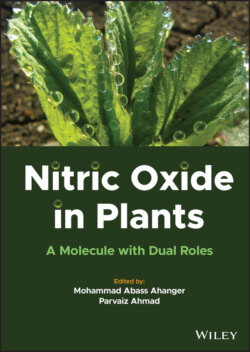Читать книгу Nitric Oxide in Plants - Группа авторов - Страница 22
2.2.1 Nitrate Reductase
ОглавлениеIn higher plants, nitrate reductase (NR, EC 1.7.1.1) is a cytosolic enzyme that facilitates the assimilation and metabolism of nitrogen (Ahmad et al. 2021). This enzyme utilizes nicotinamide adenine dinucleotide (NADH) (electron donor), molybdopterin, and heme/flavin adenine dinucleotide (FAD) (cofactors) to activate the reduction of nitrate into nitrite (Kaya et al. 2020b).Nitrate reductase is generally present as a homodimer in tetrameric form, depending upon the plant species. In addition to its primary role, nitrate reductase is involved in the production of nitrite: its activity level is quite low and makes up 1% of total nitrate-reducing ability (Mohn et al. 2019).
As well as cytoplasmic-based nitrate reductase, membrane-associated nitrite – NO reductase (Ni-NOR) – is also involved in NO production in plants. It is exclusively present in rhizome, which utilizes NAD(P)H (electron donor) to yield the NO from nitrite. It works at low oxygen pressure and in conjunction with membrane-linked nitrate reductase, which produces nitrite from nitrate. In their structural features, both cytoplasmic and membrane-bound reductase enzymes exhibit the presence of a cofactor named molybdenum (Moco) (Chamizo-Ampudia et al. 2017; Gao et al. 2019). In plants, some other Moco-containing enzymes exist, including (i) aldehyde oxidases (AOs), (ii) sulfite oxidases (SOs), and (iii) xanthine oxidases (XOs), all of which produce NO from nitrite (Bethke et al. 2004).
